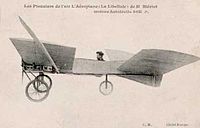Tandem wing
This article includes a list of references, related reading or external links, but its sources remain unclear because it lacks inline citations. (December 2009) |
A tandem wing arrangement has two main wings, with one located forward and the other to the rear. Both wings contribute to lift. Tandem wings are rare, but they do appear in both nature and aviation.
Tandem wing aircraft may be distinguished from:
- A biplane whose wings are stacked more or less vertically, one above the other, and where a separate tailplane surface is required,
- A aircraft (such as the Mignet Pou-du-Ciel) where the rearmost tandem wing is smaller than the forward wing, thereby resembling an outsize tailplane.
- A canard or "tail-first" configuration where the forward surface is much smaller and contributes primarily to control and/or stability.[1]
Design principles[]
A tandem wing configuration has two main wing planes, with one located forward and the other to the rear. Compared to a conventional monoplane, where the tailplane exerts a balancing downforce, both tandem wings contribute to lift. In aircraft such as the QAC Quickie Q2, the forward wing may double as support for the landing gear.
In a tandem wing design the lift vectors on the two wings are spread far apart longitudinally, allowing them to act in concert to achieve stability and control.
Tandem wings have also been used on ground-effect vehicles.
Designers using tandem wings[]
- John J. Montgomery
- Henri Mignet
- Claude Piel
- Burt Rutan
List of tandem-wing aircraft[]
- This list is incomplete. Please help by expanding it
| Type | Country | Class | Role | Date | Status | No. | Notes |
|---|---|---|---|---|---|---|---|
| Arsenal-Delanne 10 | France | 1940 | Prototype | 1 | |||
| Blériot VI | France | 1907 | designed by Louis Peyret | ||||
| Caproni Ca.60 | Italy | Transport | 1921 | Prototype | 1 | Nine-wing triple-tandem triplane. | |
| Curtiss-Wright X-19 | US | 1963 | Four rotor convertiplane | ||||
| or MAI-3 | USSR | Attack | 1937 | Prototype | 1 | [2] | |
| Langley Aerodrome | US | Experimental | 1902 | Project | 1 | Failed to take off. | |
| Lockspeiser LDA-01 | UK | Utility | 1971 | Prototype | |||
| Mauboussin Hémiptère | 1936 | ||||||
| Mignet Pou-du-Ciel | France | 1933 | Homebuilt | ||||
| Miles M.35 Libellula | UK | Experimental | 1942–1945 | Prototype | |||
| Miles M.39B Libellula | UK | Experimental | 1942–1945 | Prototype | |||
| Montgomery Aeroplane and The Santa Clara tandem wing gliders | 1903–1905 | ||||||
| Peyret Tandem | 1922 | Won the first British Glider Competition at . | |||||
| Rutan Quickie | US | 1978 | Homebuilt | ||||
| Scaled Composites ATTT | US | 1986 | |||||
| Scaled Composites Proteus | US | 1998 | |||||
| SFCA Taupin | 1936 | ||||||
| Viking Dragonfly | 1980 | ||||||
| Westland P.12 Lysander Delanne | UK | 1940 | Modified Lysander to include rear gun turret. |
Tandem wings in nature[]
Gallery[]

Montgomery The Santa Clara (1905)

Blériot VI Libellule (1907)

Langley Aerodrome, modified (1914)

Pou-du-Ciel (1933 onwards)

Miles M.39B (1943)

Scaled Composites Proteus (1998)
See also[]
- Stagger (aviation)
Notes[]
- ^ Note: tandem wings and canards differ mainly in degree: for instance, the fore-wing on the Miles M.39B is large for a canard but rather small for a tandem wing.
- ^ Yefim Gordon and Bill Gunston; Soviet X-Planes, Midland, 2000.
References[]
- Miles, George H (27 April 1944). "The Tandem Monoplane Its Merits and Drawbacks Compared with those of Tailless, Tail first and Allwing Designs : Libellula Suggested as Name for Class" (pdf). Flight.
- Spreadsheet detailing math analysis of tandem wing aerodynamics
- More math, including Flying Flea tandem wing design
- The Tandem Monoplane Does it Still Have a Future? : Some Past Experiences Recalled .. this document has now disappeared
- Reviving the Tandem
- Aerodynamic characteristics of a tandem wing configuration of a Mach number of 0.30
- Wing configurations
- Aircraft wing design
- Tandem-wing aircraft
- Aviation stubs






